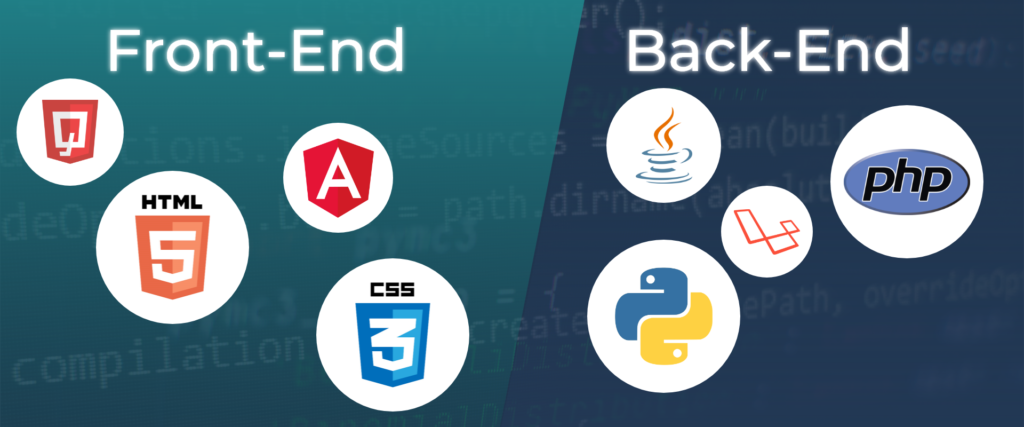Front-End vs Back-End Development what is the difference?

Have you come across the terms “Front-End” & “Back-End” development and wondered what the difference is? Lucky for you we have “compiled” a brief description on both.
Firstly, what even is a Front-End & a Back-End?
A Front-End is a system that displays information to the user without being involved in its underlying operation, handling inputs and outputs. Basically, the Front-End of a system is what a user would interact with. This ranges from your computers operating system, a well-known spreadsheet software to the most used search engine and your favourite photo sharing app.
A Back-End is a system that performs the actual processing of information. Back-end development consists of all code that is handled after the client or user makes an action on the (Front-End) interface.
The Back-End is any system that performs actions on behalf of an application or website without directly sending or receiving data with users. Front-End systems typically do not contain the complete functionality required to operate a Back-End system autonomously; they require at least one extra layer of components between them and the computer’s operating system, which acts as a communications layer translating requests from the Front-End to instructions for use by the backend component(s).
Let’s dive a bit deeper into Front-End Development.
Front-End developers are in charge of putting visual elements of a website into place. They also aid with website development duties such as navigation, buttons, and anything else that improves the site’s overall exposure.
HTML, JavaScript, and CSS are frequently utilized for this purpose to ensure that your website functions well. This allows people to interact with a website freely and easily.A Front-End developer must have a lot of technical knowledge, but the work also requires a lot of soft skills. Front-End developers must be able to work effectively with colleagues from many departments, make recommendations that have a direct impact on products.
Front-End Frameworks are constantly improving to cater for faster, dynamic and intuitive interfaces. Front-End Framework examples are:
- React- An open source Front-End framework building user interfaces or UI components. React was originally developed and used by Facebook and is still being used today.
- Angular – A TypeScript based open source web app framework which usually deal with the development of mobile and web development. Companies such as Microsoft office use Angular.
- Vue.js – A model–view–view model, open-source Front-End JavaScript framework for building user interfaces and single-page applications. Internal parts of Netflix are powered by Vue.js.
Okay, I have an idea, let’s connect the Front with the Back-End.
Server-side development is referred to as Back-End development. Databases, scripting, and website architecture are all covered. It describes the operations that take place behind the scenes when a user performs a specific activity on a website. It could be logging into an account or purchasing anything from an internet retailer. Back-End developers write code that allows browsers to interface with database information.
Successful Back-End developers know more than just how to code. They have a highly analytical mind-set, as well as a number of other attributes that aid in the creation of excellent code. The tech team includes more than just Back-End developers. They must collaborate not just with one another, but also with Front-End developers, designers, IT infrastructure teams, and others.
Back-End Frameworks are constantly being developed to support increased functionality and features to systems. Back-End Framework examples are:
- Django – An open-source backend framework based on python programming language. Suitable for the development of sophisticated and feature-rich database-driven websites like Instagram
- Laravel – a web application framework with expressive, elegant syntax. Laravel PHP Development is one of the most expressive and rich web application frameworks which is also used by Pfizer
- Express.js – An open source web application framework for Node.js, designed for building API’s and web apps such as Twitter.
Now, to bring it all together
To put into perspective – consider the Front-End as a restaurant menu; it allows you to choose from a menu of items that have been brought out from another room. Consider the Back-End to be the kitchen. It serves as a secret location where the chef prepares your meal.
Front-End developers are in charge of putting visual elements on a website, whereas Back-End developers are in charge of server-side development.
Back-End developers apply algorithms and resolve system-related difficulties, whereas Front-End developers focus on the design and UI/UX of a website or application.
We can now conclude that to create a Good Software Solution, the knowledge of both the Front-end and Back-end is needed. Without a suitable Front-end, it won’t have a UX & without a well established Back-end, it won’t ensure data security and management. So for an Innovative & Outstanding Software Solution, both are very much important.
So there we have it; Front-End and Back-End development. From an application or website perspective – both are pinnacle towards a successful build. As someone looking into a career in development, becoming specialized in either Front or Back-End will allow you to excel as key members of a development team. If you are interested in both, you may have heard the term “Full Stack Developer”, which in short is a combo of front and Back-End development!
